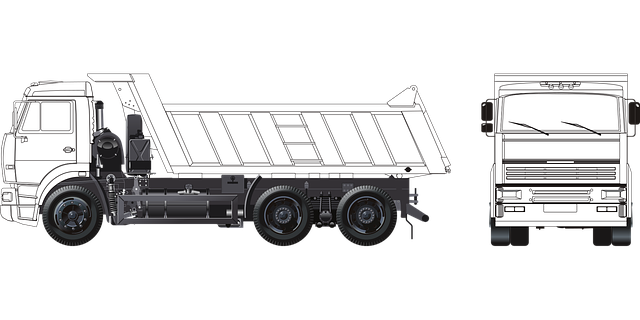Looking to register your car in California? This comprehensive guide breaks down the process step-by-step, ensuring a smooth experience. From understanding essential requirements to securing your vehicle’s unique Vehicle Identification Number (VIN) through official DMV vin verification, you’ll learn everything needed to complete the registration successfully. Get ready to hit the road legally!
- Understand California Car Registration Requirements
- Gather Necessary Documents for DMV Visit
- Perform Vehicle Identification Number (VIN) Verification
- Complete Application and Pay Fees at DMV
- Receive Your Registration Plate and Documents
Understand California Car Registration Requirements

Before registering your car in California, it’s crucial to understand the state’s specific requirements. The California Department of Motor Vehicles (DMV) mandates that all vehicles operated within the state be properly registered and have passed a safety inspection. This involves a thorough examination of critical components like brakes, lights, tires, and safety features. Additionally, the DMV requires verification of your vehicle’s Vehicle Identification Number (VIN). This process, often referred to as VIN verification, ensures the authenticity and history of your car.
A key aspect of this process is ensuring that your car meets all environmental and safety standards. You can facilitate this with a mobile VIN verifier or conduct a vin inspection at a certified location. These services streamline the verification process by using advanced technology to cross-reference your vehicle’s data against state records, making it easier for you to navigate the registration procedure smoothly.
Gather Necessary Documents for DMV Visit

Before heading to the DMV, make sure you have all the required documents for a seamless car registration process. This includes your vehicle’s registration form, proof of insurance, and a valid driver’s license or state ID. The most crucial document is the Vehicle Identification Number (VIN) verification, which can be done through various methods. For a quick and convenient option, consider utilizing mobile VIN inspection services that allow you to verify your car’s history from the comfort of your home. Alternatively, many auto parts stores offer this service as well.
Additionally, prepare any other supporting documents such as proof of ownership if the vehicle is not yours, or records of recent maintenance or repairs. Having these in hand will ensure a smoother experience during your DMV visit and expedite the registration process. Remember to check the DMV’s website for specific requirements, as they may vary based on your vehicle type and age.
Perform Vehicle Identification Number (VIN) Verification

Before registering your car in California, it’s crucial to ensure the vehicle’s authenticity and history through a Vehicle Identification Number (VIN) verification process. This step is essential as it helps protect consumers from buying stolen or counterfeit vehicles. You can perform this vin inspection yourself or use a mobile vin verifier service, which provides a convenient, on-the-go solution for this requirement.
A mobile vin verification service sends your vehicle’s unique VIN number to a database, retrieving detailed information about its history, including any previous owners, accident records, and maintenance logs. This ensures that the car you’re considering is safe, legal, and as described by the seller. It’s a straightforward process that can be completed quickly, making it an excellent option for those looking to register their cars efficiently while adhering to California’s requirements.
Complete Application and Pay Fees at DMV

After gathering all the necessary documents, it’s time to visit or contact the California Department of Motor Vehicles (DMV). You’ll need to complete an Application for Title and Registration (Form DV-140), providing detailed information about your vehicle, including its make, model, year, and unique Vehicle Identification Number (VIN). Ensure all details are accurate for a smooth registration process.
Along with the application, you’ll be required to pay several fees, including a registration fee and a VIN verification fee. The latter ensures that the DMV confirms the vehicle’s history and identifies any potential issues, which is crucial before putting your car on California’s roads. You can opt for traditional in-person payment or explore convenient alternatives like mobile vin inspection services, which allow you to complete both steps remotely, making registration more accessible and efficient.
Receive Your Registration Plate and Documents

After completing your vehicle’s purchase, it’s time to receive your registration plate and official documents. In California, this process typically involves a trip to the Department of Motor Vehicles (DMV) or, for added convenience, utilizing their online services. The DMV will conduct a vin verification, checking the Vehicle Identification Number (VIN) to ensure the vehicle matches the details in the sales documentation. This step is crucial to prevent fraud and ensure the legal ownership of your car.
You’ll be provided with a registration certificate and a set of license plates. For added peace of mind, many California residents opt for a mobile vin inspection or verification service, allowing them to complete the necessary paperwork from the comfort of their home or office. This modern approach streamlines the registration process, especially for those who value their time and convenience.
Registering a car in California involves understanding state requirements, gathering essential documents, and successfully completing procedures like VIN verification at the DMV. By following these steps outlined in our article—from preparing necessary paperwork to receiving your registration plate—you’ll be well on your way to becoming a legal California vehicle owner. Remember, accurate and prompt compliance with registration processes ensures you can confidently hit the road.
